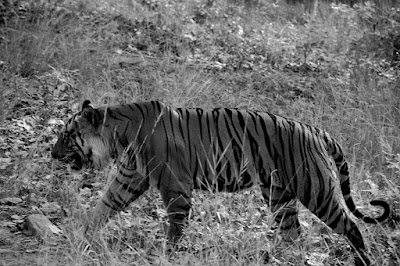A tiger for every season
Tigers, as a friend had once put it, have found a way to silently pad their way into a million hearts. She may be right, for how else can you explain, why people bundle up in layers and layers of fabric in the coldest of seasons, putting themselves through an early morning routine in wretchedly icy cold conditions 'companioned' often sadistically by cold winds to get a glimpse of the stripes? or, why else would people travel in 45 degrees of pure hellish heat routinely getting scorched by the sun to yet again watch this magnificent cat in it's realm?
It has to be a certain degree of charisma with a spoonful of mystery and of course a tumbler full of beauty and sheer majesty that shimmers down to the tail, whiskers, a shade of ochre and stripes with rippling muscles that is the tiger.
Tigers are beautiful yes but during my time spent in the forests I have come to realise that the way they look seems to change with the change of season. This, however is not a scientific observation or may not be accurate too for that matter, but it is how I have perceived the tigers in certain seasons.
In the winter season a tigers' coat seem to turn a rich shade of orange, a combination of orange with a hint of red, especially when the sumptuous winter sun (when it finally does emerge) strikes the cat with the first of it's un adulterated rays, making it gleam like silk and creating the delusion of the animal seeming bigger as it envelopes in a few strides, the entire length of its foggy, mist kissed meadow territory. A symbol of pure grace and a refreshed demeanour.
In the summer season, the tiger's coat seems more subdued, more in sync with its territory and its surroundings as if a said understanding with the rules of camouflage to hide among the drying blades of grass. It takes on a more yellow form this time of the year, often blending with the colour of the leaves on the forest floor or with the rays of the tyrannical sun beating down on un- suspecting spectators.
The white on the belly and the face seem more pronounced and the stride appears more delicate or languid as if challenged by the blazing heat. The coat a paling yellow, as if waiting much like the trees and vegetation around for the rain to beat down upon the parched for a renewed display.
In the monsoon season the tiger even though soaking wet much like its surroundings and the habitat it inhabits, seems darker. The stripes seem to be a darker shade of black while the ochre seems more pronounced. As the coat soaks in the downpour the fur with the sudden evening light, lights up with the raindrops like a bejewelled statue worthy of the every divine status it enjoys.
Lastly, at night or late evening, the tiger exhibits a more supernatural disposition. A game of light and shadows, the presence of the animal seems to own all in its path and whatever his lengthened shadowy figure touches which follows it noiselessly, except when projected on a wayside bush, the presence is heightened and appears tenfold re- iterating it's magnificence and power, warning all of the icon and symbol that is the tiger.
* (For monsoon and night sightings, have had the privilege outside of the park boundaries)




The beauty is in the imagery of this animal in your mind, Bhavs, enjoyed the read. Keep writing :)
ReplyDeleteShanky! Thank you so much and yes I shall :) glad you liked it
Delete